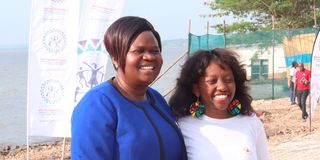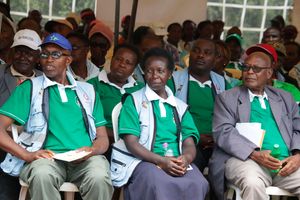Men targeted in fight against teen pregnancies, HIV and sexual abuse

Homa Bay Governor Gladys Wanga (left) with President William Ruto’s daughter, Charlene, in Homa Bay town after discussions to end triple threat on June 6.
What you need to know:
- According to the Kenya Demographic Health Survey 2022, Homa Bay is among the top five counties with the highest rate of adolescent pregnancies at 23.2 per cent.
- The county is also among those with the highest burden of HIV/Aids prevalence at 15.2 per cent against the national prevalence of 3.7 per cent.
Martha *holds her two-year-old baby close to her chest while soothing him to sleep.
Unlike other girls her age who are currently in school, the teenage mother from Ndhiwa, Homa Bay County, has been juggling motherhood with studies.
The 18-year-old girl became a mother at the age of 15 shortly after being introduced to a man by one of her close female friends. Martha says before meeting the man, she would get most of her hygiene supplies such as sanitary towels and underwear from the friend.
The teenager discloses that while she still has both parents, they have not been providing for her due to domestic fights.
“None of my parents wanted to take responsibility for my personal needs.They would quarrel most of the time, forcing me to seek an alternative means of survival,” says Martha.
Martha narrates that one day her friend announced she was no longer in a position to help the teenager out, but she volunteered to introduce her to a man who was willing to take care of her needs.
Barely two months after meeting the man, they started engaging in unprotected sex that resulted in an unplanned pregnancy.
“My teacher found out I was pregnant at four months and informed my mother, who did not take the message lightly,” says Martha, adding that by then she was in Standard Eight.
“My parents and brothers would gang up and beat me while pushing me to get married to my unborn baby’s father,” she adds.
The teenager managed to sit her Kenya Certificate of Secondary Education exams before dropping out due to lack of parental support.
Martha explains that being a mother at a younger age without a source of income came as a baggage, forcing her into selling second hand clothes to survive.
She would also sleep with other men hoping to save money to take care of her son, a practice that left her exposed to sexually transmitted infections .
“I only managed to go back to school after I was rescued by an NGO in Homa Bay County,” says Martha.
She is among hundreds of teenage girls in Homa Bay who have fallen victim to sexual and gender-based violence, leaving them either pregnant or having contracted HIV/Aids.
According to the Kenya Demographic Health Survey 2022, Homa Bay is among the top five counties with the highest rate of adolescent pregnancies at 23.2 per cent. The county is also among those with the highest burden of HIV/Aids prevalence at 15.2 per cent against the national prevalence of 3.7 per cent.
The statistics rank Homa Bay among one of the counties battling cases of triple threat namely teen pregnancies, sexual and gender based violence and new cases of HIV.
Homa Bay County AIDs and STIs Coordinator Stephen Omondi told Healthy Nation that over the last few years, there has been an emerging trend in the county — adolescents aged between the age of 15 to 19 leading in new HIV infections.
“Our other concern is the growing cases of teen pregnancy. From January to March this year, we recorded 421 pregnancies among individuals aged 15 to 19 years,” said Mr Omondi during a Media for Environment Science Health and Agriculture science café’ held in Homa Bay County.
The health coordinator said the cases were spread out in three sub-counties namely Ndhiwa, Suba and Kendu Bay.
Mr Omondi further raised concerns about the high rate of school drop-outs by teen mothers within the county.
He said a number of teenage mothers never make it back to school. “Once they drop out, the young mothers are forced to look for jobs so as to take care of their needs or settle in marriage. As a result, they end up falling into traps of men who take advantage of them, exposing them to sexually transmitted diseases.
Homa Bay Governor Gladys Wanga said up to 75 per cent of caesarean sections performed in public hospitals in the county are done on teenagers.
“It shows how high the number of adolescents who deliver in our hospitals is. We are slowly losing a generation and we must stop treating this as normal,” she said.
In an effort to curb the rising cases of triple threat, the county government in partnership with the National Syndemic Diseases Control Council (NSDCC) and a number of United National agencies has come up with a strategy advocating for male involvement.
NSDCC Chief Executive Officer Ruth Masha said the new strategy will involve sensitising girls, boys and men on the dangers of risky sexual behaviour and consequent reproductive health issues. The initiative , she noted, is in line with the council's national campaign to end triple threat by 2027.
"Triple threat is an enemy of economic and social development and we must combine efforts to eradicate it," said Dr Masha.
She said the project will see them organise awareness campaigns in schools and public places with the aim of reaching more men.
The CEO added that for the vices to end, the county must also look for ways to protect girls and women from sexual and gender-based violence.
“By sensitising the men, we hope to make them understand the dangers of engaging in sexual intercourse with the young girls including the likelihood of contracting HIV and teenage pregnancies,” said Dr Masha.





